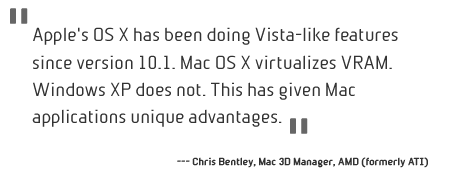|
CB:
Yes. Absolutely. Apple's entire windowing system depends
on OpenGL. That's an industry open standard. Microsoft
depends on its proprietary DirectX technology.
AFR:
With Vista...
CB:
Yes.
AFR:
Right, Apple is a key stakeholder in OpenGL. Without it the
user
experience of Mac OS X wouldn't be the same.
CB:
The thing is Mac users are always concerned they are
not getting the best stuff. They want the same as their
PC brothers. Over the past few years, since the ATI Radeon
9600, the ATI Mac drivers have combined Apple specific
code to support the advanced features and fast paths
of MacOS X together with code leveraging the best parts
of ATI's PC OpenGL drivers.
For
example, at AMD we have an entire group dedicated to
writing a really good compiler
for vertex and pixel shaders. That same compiler that
is used for the PC graphics card development is used
for the Mac cards. We use the same code. When hardware
became programmable we started being able to do this.
It changed everything -- we could expose programming
languages as the interface to the hardware. The driver
then needed to contain a compiler. AFR:
So all your AMD (ATI) graphics hardware is fully programmable?
CB:
Yes, since the Radeon 9600 all our hardware has supported
vertex and pixel shaders. The old hardware, for instance,
had the idea of a light. It had 'fixed function' circuitry
devoted exclusively to lighting calculations. With the
new hardware you don't talk about lights. Instead you
express the math done in those calculations as a vertex
or pixel shader, which gets executed by general purpose
ALU hardware on our chips.
The Latest Cards
AFR:
Okay let's get to the main question. Why should I buy the ATI
Radeon X1900 GT card? What's good about this card? Who is it
for?
CB:
Because it's great! [...laughs]

AFR:
I'm sure....
CB:
The Radeon X1900 GT is the chip in our newest most powerful
retail card for the Mac market, which is actually called
the ATI Radeon G5 Mac Edition. It is targeted specifically
to owners of the last generation of Power Mac G5 towers,
the machines with PCIe connections. There is also a sister
card, the Radeon X1900 XT, that that has additional graphics
muscle, which users can select as an upgrade for the
Mac Pro.

AFR:
This is the generation of Power Mac G5 with its own dual-core
G5 chip from IBM. It came in dual and quad models. I'm
just being clear.
CB:
Yes. These machines shipped with a default Nvidia GeForce 6600
card. For Pro users who purchased these machines with
this card our Radeon X1900 G5 Mac Edition offers a dramatic
improvement in 3D graphics performance.
AFR:
There was an Nvidia GeForce 7800 card as well as a BTO
option.
CB:
Yes, but that card is not available as an after-market
option for
users who purchased the default Apple config. Our Radeon
X1900 G5 card fits the bill nicely for users who want
more graphics power. Our
testing showed that the Radeon X1900 G5 Mac Edition was
up to 2x-5x faster than the Nvidia GeForce 6600 card
that shipped as the default in the PCIe G5s. Up to 2x
faster for vertex geometry bound
cases, and up to 5x faster for pixel bound cases, such
as Core Image and high-resolution shader heavy games.
AFR:
So what is the difference between this card and the one
that ships as an option in the middle range for the new
Mac Pros?
CB:
The Radeon X1900 G5 Mac Edition is for PCIe-based Power
Mac G5s only, hence the name. It's core processor speed
is 500 MHz while the Radeon X1900 XT is 600 MHz. Likewise,
its memory speed is 1.2 GHz while the XT card is faster
at 1.45Ghz. Additionally, the pixel shader processors
number 36 on the GT Mac Edition while the XT has 48.
The vertex shaders are the same at 8. So overall, the
XT will have around 30% faster vertex and pixel performance
than the GT.
AFR:
How is that breaking out specifically in number of pipelines?
CB:
"Pipelines" is actually becoming something
of an outmoded term. The notion of a top to bottom rendering
pipeline has been replaced by a shader engine with independent
pixel shader processors that are decoupled from the
rendering units - the functional elements that were
traditionally described as pipelines. The X1900 XT has
16 of what might be called "extreme pipelines",
with 3 parallel math execution units for every rendering
unit for a total of 48 so-called "pixel
shader processors ". The GT card has 12 sets of
these math units for a total of 36.
AFR:
Three operations per pipe per cycle.
CB:
Actually these shader processors are capable of more
than one
operation per clock cycle, depending on the type of operation,
but
generally speaking we're talking about 48 or 36 shader
operations per clock cycle respectively. This is a huge
leap compared with previous generation GPU's where there
was traditionally one pixel shader unit per pipeline.

AFR:
What matters most in graphics speed, processor or memory?
next
page: | 1 | 2 |
3 | 4 |
|






![]()
![]()